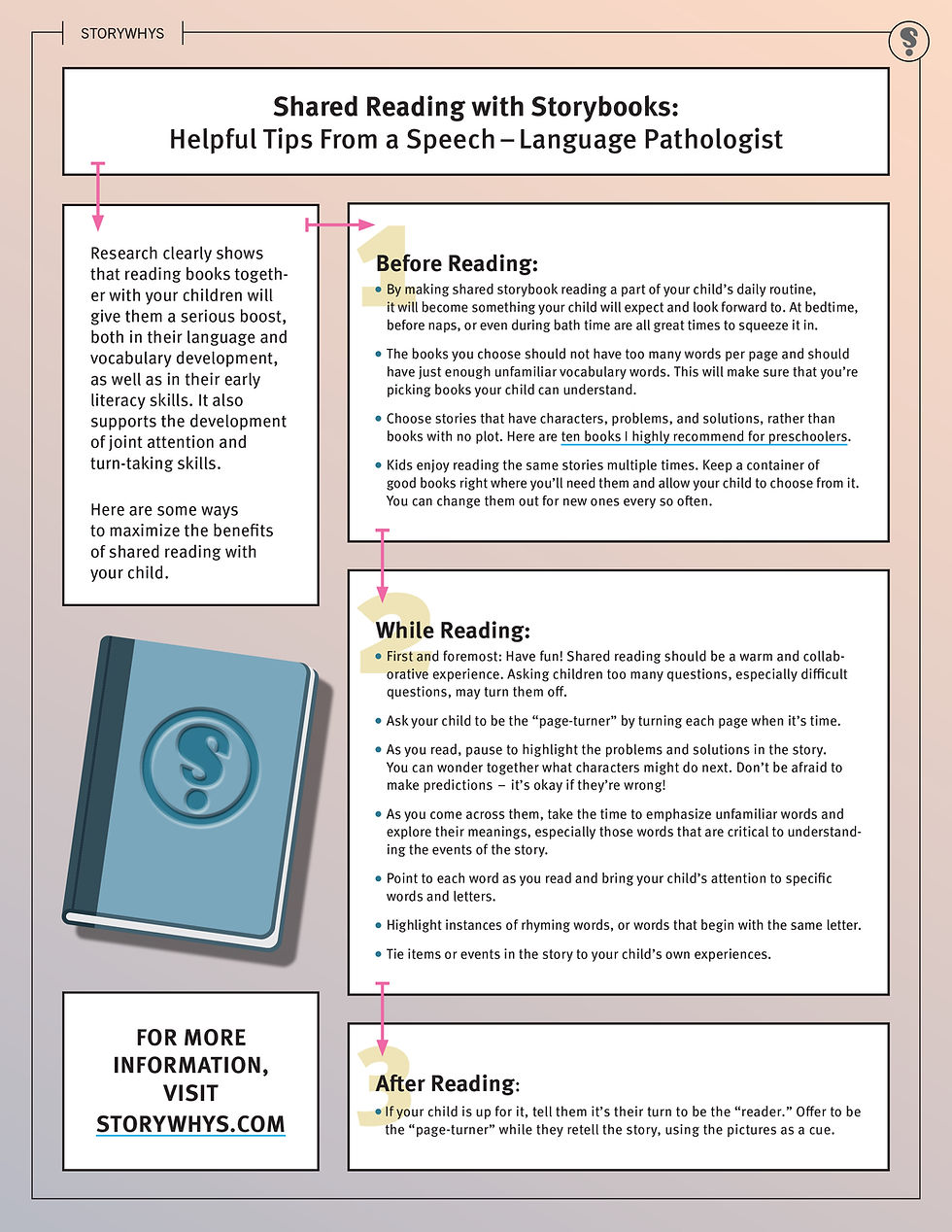Shared Reading With Story Books: Helpful Tips From a Speech-Language Pathologist
- StoryWhys

- Jan 28, 2024
- 3 min read
Updated: Aug 9, 2025
Research clearly shows that reading books together with your children will give them a serious boost, both in their language and vocabulary development, as well as in their early literacy skills. It also supports the development of joint attention and turn-taking skills.
*Free handout below*
As a speech-language pathologist, parents and other caregivers often ask me what they can do to support their child's language skills at home.
My answer? Shared reading.

The following is the advice I've often given to parents and even teachers.
Here are some ways to maximize the benefits of shared reading with young children:
While sharing storybooks with your child, there are things you can do before reading, during reading, and after reading to get the most out of your shared reading time.
Before Shared Reading:
By making shared storybook reading a part of your child’s daily routine, it will become something your child will expect and look forward to. At bedtime, before naps, or even during bath time are all great times to squeeze it in.
The books you choose should not have too many words per page and should have just enough unfamiliar vocabulary words. This will make sure that you’re picking books your child can understand.
Choose stories that have characters, problems, and solutions, rather than books with no plot. Here are ten books I highly recommend for preschoolers.
Kids enjoy reading the same stories multiple times. Keep a container of good books right where you’ll need them and allow your child to choose from it. You can change them out for new ones every so often.
While Reading:
First and foremost: Have fun! Shared reading should be a warm and collaborative experience. Asking children too many questions, especially difficult questions, may turn them off.
Ask your child to be the “page-turner” by turning each page when it’s time. This will help them learn that it is important that every word on the page is read before we can turn the page.
As you read, pause to highlight the problems and solutions in the story. You can wonder together what characters might do next. Don’t be afraid to make predictions – it’s okay if they’re wrong!
As you come across them, take the time to emphasize unfamiliar words and explore their meanings, especially those words that are critical to understanding the events of the story.
Point to each word as you read and bring your child’s attention to specific words and letters. This will help increase their alphabet knowledge, as well as their understanding of how printed language works.
Highlight instances of rhyming words or words that begin with the same letter (alliteration). This will support children's phonological awareness, which is an important foundational literacy skill.
Tie items or events in the story to your child’s own experiences. This will activate their background knowledge and can support their comprehension of the events in the story.
After Shared Reading:
If your child is up for it, tell them it’s their turn to be the “reader.” Offer to be the “page-turner” while they retell the story, using the pictures as a cue. They don't have to remember all the details, but it gives them an opportunity to try to say things in their own words and to try out novel vocabulary.
LEVEL UP YOUR SPEECH THERAPY ACTIVITIES WITH STORYWHYS
Did you find this blog post helpful? Subscribe below to get the latest blog posts, which feature lots of speech therapy ideas for busy SLPs who want to provide fun, impactful, and meaningful speech-language therapy.
StoryWhys now offers the Speech and Spell series of resources. I am always trying to tie articulation work and spelling together in my therapy and I've never found any good resources out there to help me do this. So I made my own! Many more speech sounds and spelling rules to come. They'll be 50% off for 48 hrs when new resources are added to the StoryWhys store. Find them here.
Did you know book companions can be among the best speech therapy materials for elementary students? Explore all of the StoryWhys book companions for speech therapy in my store. You'll find comprehensive book companions that target many different language skills or Spotlight Series book companions that focus on one type of skill, all using high-quality, beloved storybooks.
For quick videos to help you get the most from StoryWhys book companions, check out the YouTube channel here.
And get your FREE, 71-page book companion for speech therapy on the free downloads page.
Enjoy!







Comments